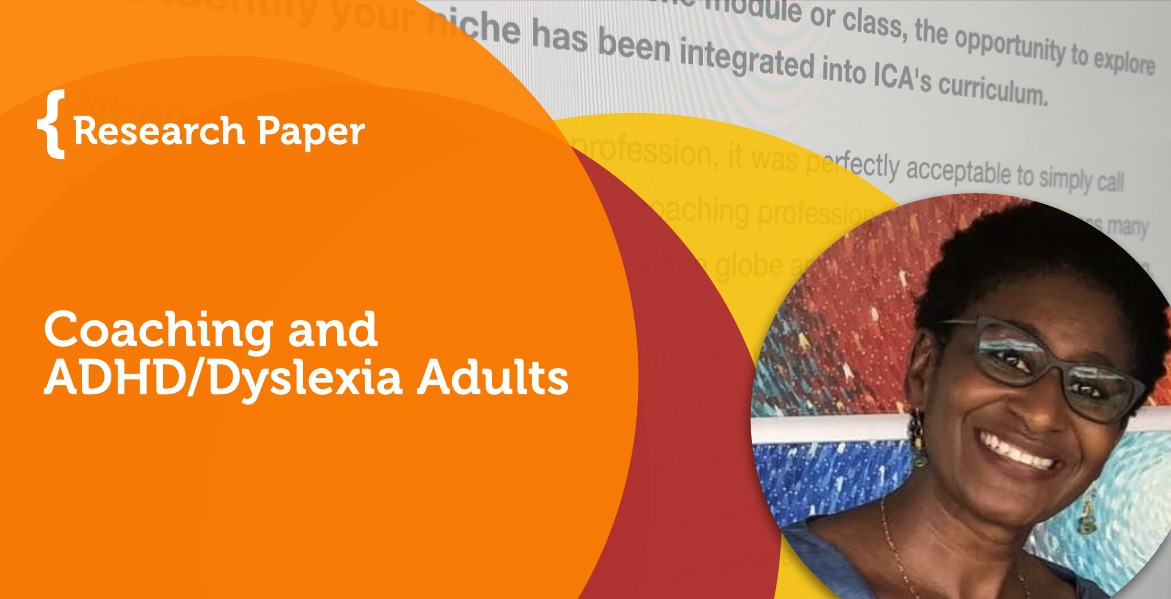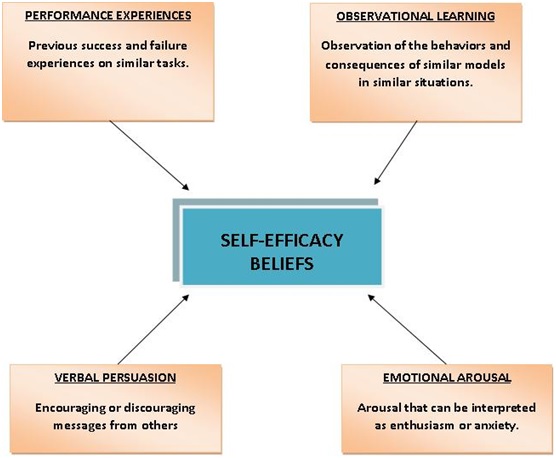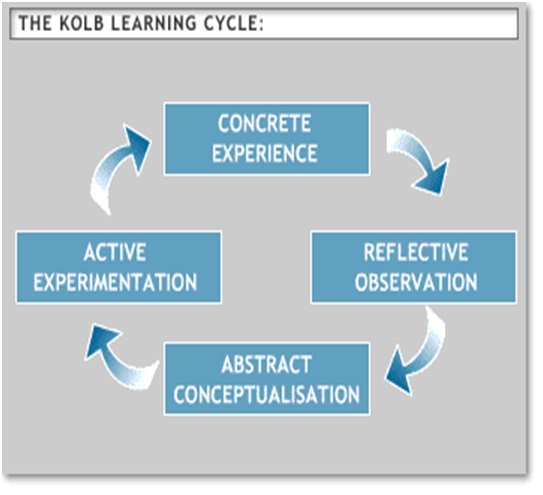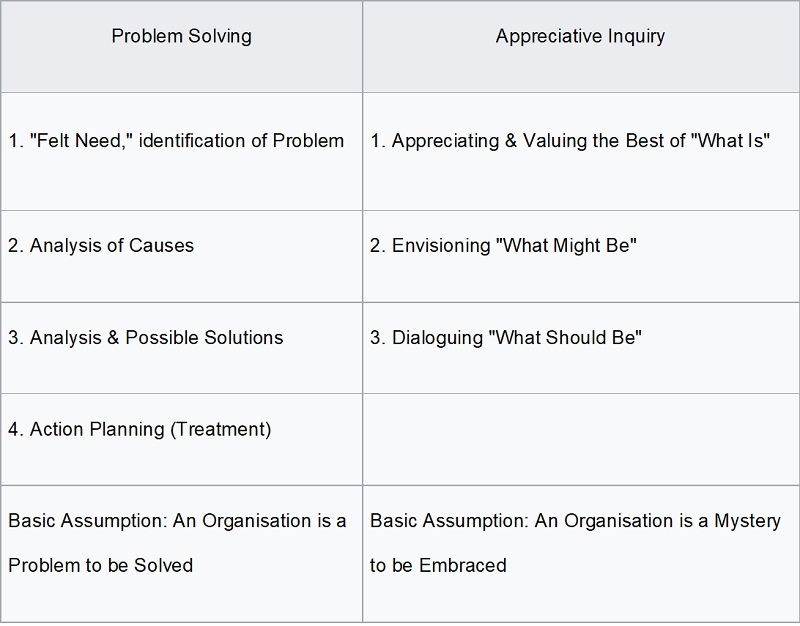 Research Paper By Florence Adu
Research Paper By Florence Adu
(Life Coach, GHANA)
Abstract
The terms ADHD and Dyslexia have a history of being commonly used in reference to learning and cognitive disabilities in children; often spotted by educationists in the classrooms or lecture halls (Shahrebabaki, 2018).
From the occasional sharp mood swings to disorganisation and anxiety, it is frequently assumed that such indications of ADHD/Dyslexia lessen as the child grows; however, a contrary report on Cognitive Behaviour Therapy (CBT) suggests otherwise.
It seems obvious to professionally accredited coaches that coaching would help a Dyslexia or ADHD coachee, in the same way as most other coachees. This is broadly true. However to effectively coach and work with an identified or not identified Dyslexia /ADHD coachee having a framework and arrange of tools could better serve the clients goals and objectives of this type of client.
This paper is prefaced by the writer’s personal experience of ADHD and Dyslexia. It proceeds to include two main takeaways under the sub-headings: 1) Finding Identifiers -markers that enable coaches to recognise ADHD/Dyslexia behaviours in their coachee and 2)Seeking Modifiers -dissecting and adapting the schools of thought of Kurt Lewin and John Dewey, to introduce and discuss models, tools and frameworks within coaching literature supporting learning and action.
Coaching is a non-clinical intervention. The relationship between dyslexia and coaching is not approached here as a clinical intervention, but to investigate the factors that may present. Coaching is ultimately about learning and action. Building tools and exploring more theories that will build the professional body of knowledge.
Preface
Having discovered later in life that I was mild Dyslexia, it became imperative for me to build frameworks and references that suited my preferred way of work and life so that I may live as optimally as possible.
Recollections of my 2nd year in schools age 6 though mostly fond, were coloured by writing lessons behind an imposing desk, with my kind and obviously sensitive headmaster, while I concentrated on mastering the repeated technique of the letters ‘N’, ‘M’ and ‘W’. Practising until my ‘M’ no longer interchanged with my ‘W’. I was happy because I wanted to be able to write my names properly.
1973 was
- my popular years desk-top-dancing, vibrant, bursting with energy and inarguably one of the fastest runners at my infant and junior school; I was never consciously aware that I had a learning or cognitive differences and rarely felt cared to think I was challenged. If not for much else, being one of the only two black children in my infant school was the only thing I considered ‘different’ about me.
Embracing the terms ADHD and Dyslexia in adulthood was a decision I made reluctantly. Butfervently holds on to an empowering interpretation of those labels. So that what is to the world a ‘neurological disorder,’ has come to be a gift. A unique and golden combination of behaviours I continue to use to enhance my life.
One in 10 Britons have dyslexia: that is more than 6m people. Just imagine the difference we could make if every one of these people were encouraged to achieve their potential and strive to make their dreams a reality. It’s time to make a difference. Richard Branson Made by Dsylexia
Defining Dyslexia/ADHD and within Coaching
Dyslexia is generally addressed as in terms of the neurological science and ADHD from behavioural science. I have justified the use of both concepts, whilst looking at the limited research available and focusing on the development of the coaching field rather than the conditions.
Dyslexia spans across a range of intellectual abilities; being often described as occurring in a continuum and affecting fluency in reading and comprehension, difficulties in verbal memory and processing speed and faulty decoding abilities (Ransby; Swanson, 2003).
In adults, however, these lapses in reading, comprehension and vocabulary may be ambiguous but may instead, reveal themselves psychologically creating mannerisms that the unskilled observer could assumedly attribute to indications of Attention Deficit (Hyperactivity) Disorder (ADHD) (Boada, Willcutt, Pennington, 2012).
ADHD definitions generally follow, this list, with clinical definitions, include not being able to control impulses can range from to mood swings and outbursts of anger, bipolar, and anxiety.
Coaching is not required to certify the existence of any medical or other diagnosed coachee.
Coaching is defined by the International Coaching Federation as partnering with clients in a thought-provoking and creative process that inspires coachees to maximise personal and professional potential.
In fact, many coachees arguably have not taken any form of medical assessment. With between 3-7% of the population showing indicators a significant per cent of clients is within ADHD or Dyslexia.
The above is not to suggest that Dyslexia and ADHD are interrelated so that where one exists the other is does
Seeking Modifiers
Coaching is defined by the International Coaching Federation as partnering with clients in a thought-provoking and creative process that inspires coachees to maximise personal and professional potential.
Very little research exists in coaching literature directly related to coaching Dyslexia/ADHD adults. Yet coaches have to be sensitive to coachees, who struggle, continuously with memory, time management and organisational skills that such patterns may be part of an adult under-diagnosed adult Dyslexia /ADHD population.
The skills and techniques taught to accredited coaches focus on the coachee as the agent. From the theoretical frameworks, models, tools and resources available, it would suggest that a coach can effectively coach Dyslexia and ADHD. However, a basic knowledge of the above could provide an even more effective relationship and outcomes.
An approach to effectively coaching persons with Dyslexia/ADHD behavioural indicators or coaching persons diagnosed with either or both of the conditions is currently developing from coaching frameworks and models with existing theories of learning. The following are those I found of most interest.
Learning theories include the Pavlov-dog Classical Conditioning Theory; responsible for conditioning reflexive behaviour by pairing a neutral stimulus with one naturally occurring. Repeating the pairing a number of times and observing the amount of time it takes for the neutral stimulus to trigger the desired reflex (S.Smith; E.R. Guthrie (1921)).
The Humanist Approach is a Facilitation Theory developed by Carl Rogers and his contemporaries, rests on the premise that learning occurs by the facilitation of the educator who establishes a comfortable, idea-stimulating learning environment with positive acknowledgment and active listening.
The third theory of interest in the coaching of persons showing ADHD/Dyslexia symptoms is the Skinner’s Reinforcement Theory which focuses on generating the desired behaviour through positive reinforcement using language, image, voices to reinforce the coachee’s efforts and resilience towards coaching results.
The final theory, of interest the Social Cognitive (Learning) Theory, links goal setting and self-efficacy – a key step in any coaching process but even more so for the process of coaching persons in which ADHD/Dyslexia indicators are assessed as they experience self-doubt, stress and inherent threat of performing unsuccessfully in unfamiliar tasks a lot more frequently than many persons without ADHD/Dyslexia behavioural and learning indicators.

Figure 1 Self-Efficacy and Social Cognitive Theories – PSYCH 484. Experimental Learning Theory (ELT)
So far, this paper has highlighted coaching as defined by the International Coaching Association, it has defined ADHD/Dyslexia as separate conditions and how they interplay in a section titled ‘Finding Identifiers’ and in ‘’Seeking Modifiers”, this paper has linked existing coaching methods to learning theories in finding alternative approaches to coaching ADHD/Dyslexia persons or coachees who display ADHD/Dyslexia learning and behavioural mannerisms.
This final part is an extension on “Seeking Modifiers”. Here the writer discusses a couple of Kurt Lewin’s change management theories as, though regularly attributed to organisational change, Lewin’s 3-step model including his exposition on Field Theory; Group Dynamics and Action Research (S.T.Hussain, S.Lei, T.Akram, M.J.Haider, S.H.Hussain, M.Ali) are adaptable as suitable tools towards coaching adults with Dyslexia and ADHD behaviours.
Lewin, a scholar and humanitarian maintained a resolve to improving or alleviating malaising human conditions (A.Kritsonis, 2005). A resolve that forms a unifying theme between his work and the work of a coach of Dyslexia and ADHD adults. Here, two out of the three of Lewin’s expositions is focused on: The Field Theory and the ‘Felt-Need’ theory derived from his work on Group Dynamics (B.Burnes, 2004).
Lewin’s Field Theory borrows from the philosophy of Gestalt psychologists; being conceptualised from the view that ‘the group to which an individual belongs forms the grounds on which his perceptions, feelings and actions belong’ (Frew J.E. (1983)).
The Field Theory attempts to map the proposed group behaviour by observing symbolic references within the environment or ‘field’ that change both group and individual behaviour within a present situation or ‘status quo’ (Lewin, K. (1951)).
Lewin calls the ‘status quo’, a ‘quasi-stationary equilibrium which though patterned and relatively predictable, fluctuates constantly according to sudden alterations in circumstances on the group (Lewin, K. (1951)).
These changes or forces, be they in diminished or strengthened form, may be slow or sharply recognisable so that they radically shift personal, organisational or societal circumstances into a new equilibrium otherwise termed by Lewin as a ‘quasi-stationary equilibrium.
This, though the technology is an important consideration for coaches working with ADHD/Dyslexia coachees as understanding or noting where the coachee experiences a quasi-stationary equilibrium be it at work, at home or internally, the coach is could be informed of where the most attention to the coaching process may follow. As at that quasi-stationary equilibrium, the ADHD/Dyslexia coachee would be challenged to adopt a new (soft or technical) skill (Burnes B., (2004)).
Here, the ‘field’ becomes the coaching process and together map symbolic references in the course of coaching sessions (with the coachee), that shifts the coachee’s quasi-stationary equilibrium and brings a shift or adjustment.
Having to adjust is increasingly frequent and can be more cognitively draining for the ADHD/Dyslexia coachee.
The coach’s role will be to acknowledge and facilitate the coachee’s movement through the goal-directed, self-regulatory cycle which the individual sets a goal, to develop a plan of action, begins an action, monitors and evaluates their performance, and based on this evaluation, changes their actions to further performance enhancement and reach their goals.
The important thing about the coaching dialogue when mapping symbolic references within the ‘field’ of the coachee’s experience, is that it starts with where the individual is (i.e. the individual’s experience and preferred learning style), and allows as much freedom to learn as the individual can cope with.
The coachee sets the agenda, not the coach. It is a gradual process of expanding the quality and scope of the individual’s learning capability. Hence, in the Coaching process, the coach starts working with and honouring the preferred learning style of the individual, and gradually enhances the individual’s ability to move through the complete experiential learning cycle.

Figure 2 Experiential Learning Theory – University of Minnesota Duluth. Kolb learning cycle: 1984 (8)
By continually mapping these symbolic references, a coach may better guide the coachee away from disoriented goal-framing and goal commitment and ease feelings of anxiety and frustration associated with new life events or tasks at work. Additionally, the learning of coaching outcomes becomes dynamic, experiential and holistic; thus guiding the Dyslexia/ADHD coachee make alterations to variables within his or her environment independently.
The second-tier of Lewin’sthesis is of equal relevance to discovering coaching methods unique to Dyslexia/ADHD coachees or coachees with Dyslexia/ADHD mannerisms.
‘Group dynamics’ or ‘group relations’, Lewin shows interactions with persons who sought his help in the field of group relations. He noted three issues these clients had being: 1. The nature of the present condition; 2. The dangers are existent within the present conditions and 3. Action plans in relation to the stated nature of the present condition and the dangers existent within it (Lewin, K. (1951)).
Delving further into these three issues, Lewin reiterated the importance of action-related change coinciding with a ‘felt-need’ – an intrinsic realisation by the individual or coachee of the necessity of that change; the absence of which makes change problematic.
It is this aspect of action-related change coinciding with the client’s ‘felt-need’ that this writer observes as being transferrable to the coaching of Dyslexia/ADHD coachees.
There are a couple of models available to coaches when navigating the client or coachee’s ‘felt-need’: In keeping with the objectives of the paper, models that resonate, from learning theories and research have been selected.

The Appreciative Inquiry method attempts to use ways of asking questions and envisioning the future in order to foster positive relationships and build on the present potential of a given person, organisation or situation. The model thus aids the coachee in an introspective exercise to create self-generated solutions.
An example of the model utilises is:
- DISCOVER The identification of organisational processes that work well.
- DREAM The envisioning of processes that would work well in the future.
- DESIGN Planning and prioritising processes that would work well.
- DESTINY (or DEPLOY) The implementation (execution) of the proposed design.
It is true that where the Dyslexia/ADHD coachee or coach with ADHD/Dyslexia characteristics has autonomously elected to seek a (Dyslexia/ADHD) coach a ‘felt-need’ already exists.
However, it seems highly necessary, that to improve performance in the lives of ADHD/Dyslexia coachees and coachees with ADHD/Dyslexia behaviours, ‘the coach should be aware of repeatable models they may be using the coaching process and apply them in a multi-sensory manner in order to make the coachee’s identification of the ‘felt-need’ and goal-setting exercise engaging, automatic and long-term’.
In reinforcing Lewin’s ‘felt need’ which is the coachee’s independent realisation for change; the coach may also employ the Deweyan method of ‘reflective practice’. The Appreciative Inquiry method above is partly characteristic of this.
John Dewey introduced ‘reflective practice’ as an alternative to traditional learning approaches (J.Dewey. 1938). As Dyslexia/ADHD adults tend to be those who were aided by alternative, creative and differentiated learning methods when younger; the ADHD/Dyslexia coachee or coachee with ADHD/Dyslexia mannerisms will benefit hugely or event requires from a coaching process that is multi-sensory while continually imploring them to churn a subject of inquiry over in their minds in a reflective manner (Sikandar, A. (2016)).
Adopting this tool as a coach also systematically enhances the coachee’s awareness of the developments (strengths, weaknesses) occurring at work, at home or cognitively with regards to his/her thinking patterns and guarantees deliberate long-term growth.
In summary, the view is that coaching of persons with Dyslexia/ADHD behaviours is not something that an Accredited and trained coach cannot apply their training and experience to. However, specialist/Niche for Dyslexia/ADHD coaching is a welcome development. With the support of the Professional bodies, they are and provide support for both Course/Trainers, Coach and Coachees and a source for research and development for the profession and practice.
References
Arsenault, P.J. (2018). Cognitive Behavioral Therapy as a Supplemental Treatment for Adolescents with Learning Disabilities
Boada, R., Willcutt, E.G., Pennington B.F., (2012). Understanding the Comorbidity Between Dyslexia and Attention-Deficit/Hyperactivity Disorder, Vol.32, No.3, 264-284.
Brock, V.G. (2008).Grounded Theory of the Roots and Emergence of Coaching (Unpublished doctoral dissertation). International University of Professional Studies, Maui, Hl.
Burnes B. (2004), Kurt Lewin and the Planned Approach to Change: A Re-appraisal
Burnes, B. (2004), Kurt Lewin and Complexity Theories: Back to the Future? JOCM, Vol.4., No.4, 309-325
Clay, R.A. (2002). A Renaissance for Humanistic Psychology: The Field Explores New Riches While Holding on its Past.” American Psychological Association Monitor, 33(8).
Dewey, J. (1938). Experience and Education. New York: Collier Books, Macmillan.
Frew J.E. (1983), Encouraging What is not Figural in the Gestalt Group. Specialists Group Work, 8: 175-181.
Harpin VA, 2005. The Effect of ADHD on the Life of An Individual, Their Family and Community from Preschool to Adult Life. Arch Dis Child 2005; 90(Suppl I):12-17. doc:10.1136/adc.2004.059006
Kritsonis A. (2005), Comparison of Change Theories, IJMBA, Vol.8, No.1
Lewin, K. (1951), Field Theory in Social Science. New York: Harper & Row.
Maslow, A.H. (1943). A Theory of Human Motivation. Psychological Review, 50(4), 370-396.
Ransby, M.J.; Swanson, H.L. (2003).Reading Comprehension Skills of Young Adults with Childhood Diagnoses of Dyslexia.
S.T.Hussain, S.Lei, T.Akram, M.J.Haider, S.H.Hussain, M.Ali (2016). Kurt Lewin’s Change Model: A Critical Review of the Role of Leadership and Employee Involvement in Organisational Change.
Sako E., (2016). The Emotional and Social Effects of Dyslexia, EJIS, Vol.2 Iss.2
Sikandar, A. (2016), John Dewey and His Philosophy of Education. Journal of Education and Educational Development (JEED)
Smith, S., & Guthrie, E.R. (1921). General Psychology in Terms of Behaviour. New York, Appleton.
ADHD Coaching Academy https://addca.com